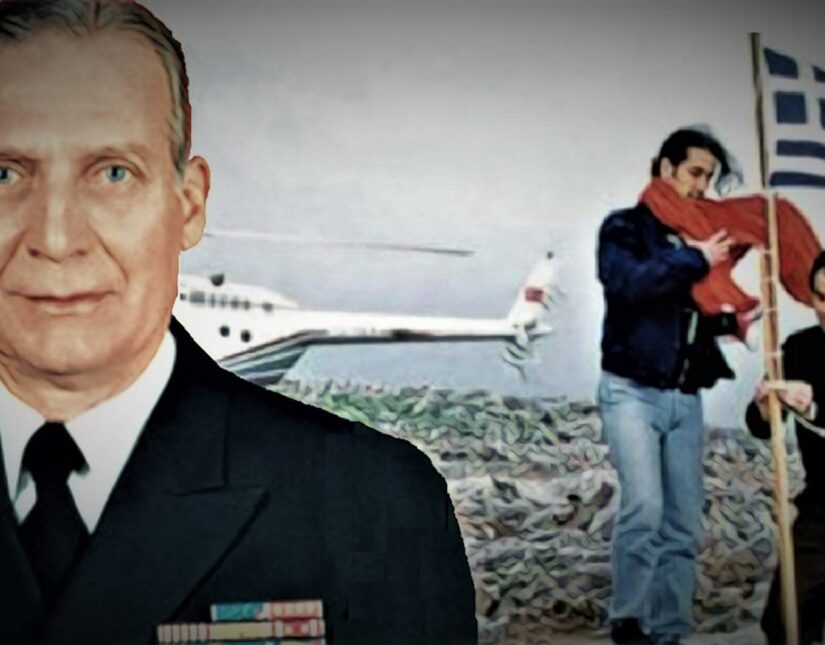Stavros Lygeros: The Turkish admiral who in 1991 announced the Imia incident – The “gray zones” to The Hague!
29/01/2021
The 25 years since the crisis at Imia may coincide with the resumption of exploratory contacts, but the Turks do not miss an opportunity to emphasize what they had won at the time: they “grayed” the two islets and mainly used this “graying” to challenge Greek sovereignty over 152 Greek islands and islets in the eastern Aegean.
At this time, after all, we have small episodes in the area of Imia, since Turkish Coast Guard boats prevent Greek fishing vessels from fishing there. Besides, every year on such days, the Turkish media, using war tones, touts that their warships are preventing Greece from carrying out a “provocation”.
What they mean by provocation is that an official throws a wreath on the rocky islet, or in the surrounding sea area where the three members of the crew of the fatal helicopter died at the time! In other words, they do not even allow Greece to honor its dead on the spot! In addition, traditionally on such days every year Ankara orchestrates a communication attack. Its goal is to recall the Turkish victory of 1996 and to create the impression that it is still able today to regulate what Greece can and cannot do not only in Imia, but more generally in the Aegean and the Eastern Mediterranean.
The “Imia model”, ie the landing of Turks on a Greek island, may have been on the shelf as a method of provoking a Greek-Turkish crisis, but this does not mean that in a situation that Ankara deems appropriate, it will not be reactivated. The Kemalist opposition, after all, accuses the Erdogan government of allowing Greece to “occupy 152 Turkish islands”! As was shown last summer, the current regime prefers the method of illegal seismic surveys (Oruc Reis), the next step of which is to send a drilling rig to a potential Greek EEZ.
Back in 1996
But let us take a leap into the past, because that crisis has much to teach us today. So, well before he became prime minister (January 1996), Simitis was faced with the crisis in Imia. The Greek manipulations led Greece to a defeat, which caused a feeling of humiliation. The leadership of the armed forces had a serious responsibility, but the main responsibility always lies with the government. With this crisis, Ankara tested the resilience of the then-new Greek government and drew dangerous conclusions.
The Turks constantly raise expansionist claims and then call on Athens to negotiate, that is, to share Greek sovereign rights. In Imia, however, for the first time, Ankara not only claimed territory but also created a fair accompli. That is why Simitis’ assurance in Parliament immediately after the crisis that nothing had changed from what was valid before had sounded ironic.
The first mistake of the Greek side was that it militarized the crisis by sending a detachment to Imia. The rocky islets of both states are numerous and unprotected. It would be enough for the port authorities to remove the Turkish flag. From the moment Athens decided to send troops, it was a disastrous mistake not to place them on both islets. At night and in bad weather, it was relatively easy for a dinghy with Turkish commandos to come ashore without being seen and create the impression of a Turkish military success.
The compromise of defeat
There the scales were tilted. If, after the disembarkation of the Turks, the Greek Navy had attempted to clear the second islet of the Turkish commandos, it would have escalated the confrontation vertically with unpredictable consequences. And the possible hot incident would be attributed to Greece. There was, of course, the alternative to the Greek Navy landing a commando on a neighboring Turkish islet to create an equivalent accomplishment and therefore Athens could negotiate a mutual withdrawal on an equal footing with Ankara. For such a move, however, there was neither a forecast nor a staff plan.
With the wrong manipulations, the Simitis government was trapped in the half-false dilemma of “war or the compromise of defeat” and accepted the Holbrooke formula (no soldiers, no flags, no ships). It is worth noting, in fact, that the formula had actually been accepted by the then Foreign Minister Pangalos before the Turks even disembarked.
The Simitis government was completely taken by surprise. That is why it had underestimated the incident with the sinking of the Turkish merchant ship in Imia several days before. This is proved by the relevant statement of Pangalos in “Vima” newspaper in those days. And yet, the qualitative escalation of Turkish expansion with the projection of territorial claims was not a thunderbolt out of the blue. The government and the relevant state mechanisms simply fell asleep despite that Ankara had warned about what it was planning.
The warning of the Turkish admiral in 1991
In June 1991, shortly before then-US President Bush’s visit to Athens and Ankara, the then commander of the Turkish fleet, Admiral Irfan Tinaz, had publicly claimed that the Aegean islets were not Greek territory. I had personally recorded it in my article in “Kathimerini”. Shouldn’t this statement have been recorded and evaluated by the competent Greek services?
Much more so, that at the end of 1989, Turkey had used the Greek islet of Zourafa (east of Samothrace) for live fire training during a naval exercise. At that time, the Mitsotakis government had avoided taking any steps in order not to aggravate the climate! In fact, it was confirmed once again that Ankara is carefully planning and preparing for each of its new expansionist moves, indirectly observing Greek reactions.
Imia ‘unravels the sweater’
By promoting the expansive theory of “gray zones”, Turkey did not aim to extract from the Greek territory two rocky islets located next to the border. The Imia rocky islets themselves are of negligible importance. They acquired great importance, because Ankara’s goal was and remains to expand the questioning of Greek sovereignty and to turn a significant part of the Aegean into a “gray zone”. Ciller’s statement to Hurriyet in those days was very clear.
He raised claims for 152 islands and islets, claiming that “until now Turkey subconsciously accepted that these islands actually belong to Greece. We will change that. ” It should be noted that with the Italian-Turkish protocol of 1932 for the demarcation of the borderline between Turkey and the Dodecanese, Ankara had officially recognized that Imia belongs to the Dodecanese. It is recorded, in fact, by official Turkish maps of that time.
As for the islands north of the Dodecanese, the Treaty of Lausanne is absolutely clear. It states that in Greece the large islands (Lemnos, Lesvos, etc.) and the adjacent islets are granted. And to leave no room for doubt, it clearly states that in Turkey are granted only those islands that are within the zone three miles from the coasts of Asia Minor.
The “gray zones” also at The Hague – The departure of Simitis
After the Imia crisis, according to information that was never refuted, Athens had asked the Americans to present as their own the idea of referring the “gray zones” to the International Court of Justice in The Hague. When Washington submitted the proposal, the Simitis government was quick to accept it. The next day, however, after strong reactions, he withdrew, stating that Greece has no reason to ask for a referral.
The truth is that no state proposes the way in which the enemy power will promote the questioning of its national sovereignty. There is no international precedent for a state to leave its territorial integrity in the hands of some foreign judges. In our case to decide whether Fourni, Oinousses, Agathonisi, Pserimos and so many other and inhabited islets will remain Greek or will be ceded to Turkey!
All of the above may seem like historical references to some, but in reality it is at the “heart” of the Greek-Turkish conflict to this day. And these issues will enter through the “window” and into the new cycle of exploration that has just begun. That is why let us start learning from the past, when in fact it has a lot to teach us.





